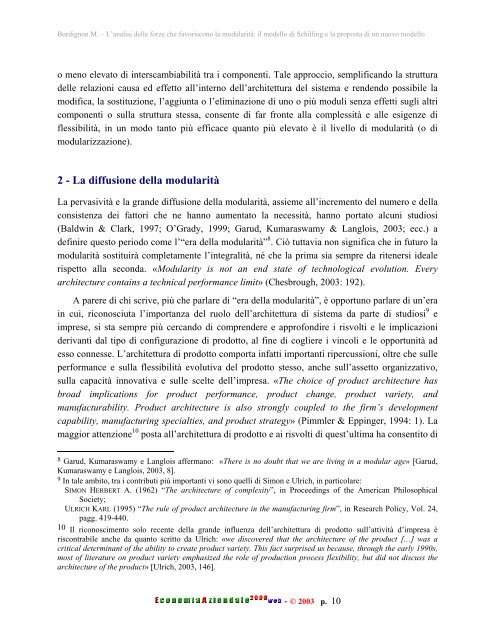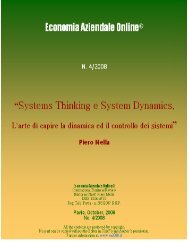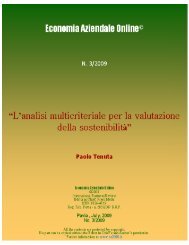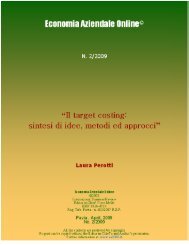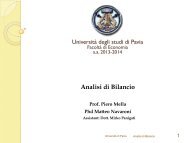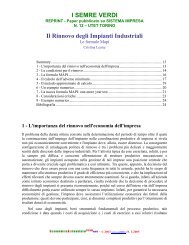il modello di Schilling e la proposta di - Economia Aziendale Online
il modello di Schilling e la proposta di - Economia Aziendale Online
il modello di Schilling e la proposta di - Economia Aziendale Online
- No tags were found...
Create successful ePaper yourself
Turn your PDF publications into a flip-book with our unique Google optimized e-Paper software.
Bor<strong>di</strong>gnon M. – L’analisi delle forze che favoriscono <strong>la</strong> modu<strong>la</strong>rità: <strong>il</strong> <strong>modello</strong> <strong>di</strong> Sch<strong>il</strong>ling e <strong>la</strong> <strong>proposta</strong> <strong>di</strong> un nuovo <strong>modello</strong>o meno elevato <strong>di</strong> interscambiab<strong>il</strong>ità tra i componenti. Tale approccio, semplificando <strong>la</strong> strutturadelle re<strong>la</strong>zioni causa ed effetto all’interno dell’architettura del sistema e rendendo possib<strong>il</strong>e <strong>la</strong>mo<strong>di</strong>fica, <strong>la</strong> sostituzione, l’aggiunta o l’eliminazione <strong>di</strong> uno o più moduli senza effetti sugli altricomponenti o sul<strong>la</strong> struttura stessa, consente <strong>di</strong> far fronte al<strong>la</strong> complessità e alle esigenze <strong>di</strong>flessib<strong>il</strong>ità, in un modo tanto più efficace quanto più elevato è <strong>il</strong> livello <strong>di</strong> modu<strong>la</strong>rità (o <strong>di</strong>modu<strong>la</strong>rizzazione).2 - La <strong>di</strong>ffusione del<strong>la</strong> modu<strong>la</strong>ritàLa pervasività e <strong>la</strong> grande <strong>di</strong>ffusione del<strong>la</strong> modu<strong>la</strong>rità, assieme all’incremento del numero e del<strong>la</strong>consistenza dei fattori che ne hanno aumentato <strong>la</strong> necessità, hanno portato alcuni stu<strong>di</strong>osi(Baldwin & C<strong>la</strong>rk, 1997; O’Grady, 1999; Garud, Kumaraswamy & Langlois, 2003; ecc.) adefinire questo periodo come l’“era del<strong>la</strong> modu<strong>la</strong>rità” 8 . Ciò tuttavia non significa che in futuro <strong>la</strong>modu<strong>la</strong>rità sostituirà completamente l’integralità, né che <strong>la</strong> prima sia sempre da ritenersi idealerispetto al<strong>la</strong> seconda. «Modu<strong>la</strong>rity is not an end state of technological evolution. Everyarchitecture contains a technical performance limit» (Chesbrough, 2003: 192).A parere <strong>di</strong> chi scrive, più che par<strong>la</strong>re <strong>di</strong> “era del<strong>la</strong> modu<strong>la</strong>rità”, è opportuno par<strong>la</strong>re <strong>di</strong> un’erain cui, riconosciuta l’importanza del ruolo dell’architettura <strong>di</strong> sistema da parte <strong>di</strong> stu<strong>di</strong>osi 9 eimprese, si sta sempre più cercando <strong>di</strong> comprendere e approfon<strong>di</strong>re i risvolti e le implicazioniderivanti dal tipo <strong>di</strong> configurazione <strong>di</strong> prodotto, al fine <strong>di</strong> cogliere i vincoli e le opportunità adesso connesse. L’architettura <strong>di</strong> prodotto comporta infatti importanti ripercussioni, oltre che sulleperformance e sul<strong>la</strong> flessib<strong>il</strong>ità evolutiva del prodotto stesso, anche sull’assetto organizzativo,sul<strong>la</strong> capacità innovativa e sulle scelte dell’impresa. «The choice of product architecture hasbroad implications for product performance, product change, product variety, andmanufacturab<strong>il</strong>ity. Product architecture is also strongly coupled to the firm’s developmentcapab<strong>il</strong>ity, manufacturing specialties, and product strategy» (Pimmler & Eppinger, 1994: 1). Lamaggior attenzione 10 posta all’architettura <strong>di</strong> prodotto e ai risvolti <strong>di</strong> quest’ultima ha consentito <strong>di</strong>8 Garud, Kumaraswamy e Langlois affermano: «There is no doubt that we are living in a modu<strong>la</strong>r age» [Garud,Kumaraswamy e Langlois, 2003, 8].9 In tale ambito, tra i contributi più importanti vi sono quelli <strong>di</strong> Simon e Ulrich, in partico<strong>la</strong>re:SIMON HERBERT A. (1962) “The architecture of complexity”, in Procee<strong>di</strong>ngs of the American Ph<strong>il</strong>osophicalSociety;ULRICH KARL (1995) “The rule of product architecture in the manufacturing firm”, in Research Policy, Vol. 24,pagg. 419-440.10 Il riconoscimento solo recente del<strong>la</strong> grande influenza dell’architettura <strong>di</strong> prodotto sull’attività d’impresa èriscontrab<strong>il</strong>e anche da quanto scritto da Ulrich: «we <strong>di</strong>scovered that the architecture of the product […] was acritical determinant of the ab<strong>il</strong>ity to create product variety. This fact surprised us because, through the early 1990s,most of literature on product variety emphasized the role of production process flexib<strong>il</strong>ity, but <strong>di</strong>d not <strong>di</strong>scuss thearchitecture of the product» [Ulrich, 2003, 146].- © 2003 p. 10


